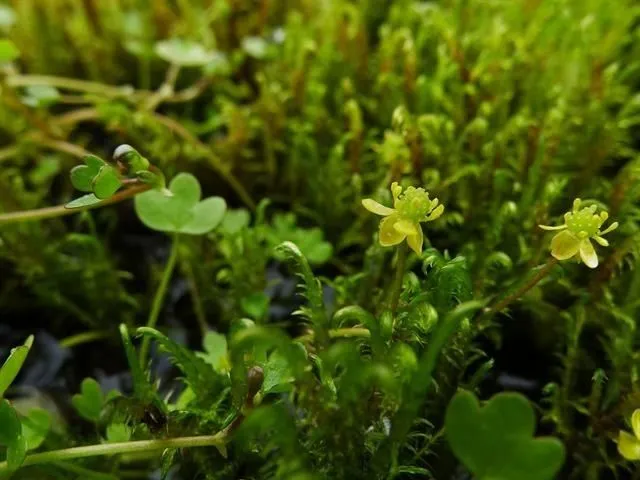
Author: Rottb.
Bibliography: Skr. Kiøbenhavnske Selsk. Laerd. Elsk. 10: 458 (1770)
Year: 1770
Status: accepted
Rank: species
Genus: Ranunculus
Vegetable: False
Observations: Subarctic & Subalpine Northern Hemisphere
The High Northern Buttercup, scientifically named Ranunculus hyperboreus, is a remarkable plant that thrives in the subarctic and subalpine regions of the Northern Hemisphere. Described in 1770 by the botanist Rottbøll, this resilient member of the Ranunculaceae family has adapted to some of the most challenging environments on the planet.
This buttercup species is characterized by its delicate, bright yellow flowers which stand out against the often harsh and stark landscapes of the north. The blooms are a visual testament to the plant’s endurance, bringing a splash of color to mountainous and near-Arctic terrains where few other plants can survive.
Ranunculus hyperboreus has a unique ecological niche. It is typically found in moist, wetland areas such as bogs and along stream banks in its native range. These areas offer the specific conditions it needs for growth, including consistent moisture and cool temperatures. The plant’s ability to thrive in such settings demonstrates its specialized nature and its significant role in these fragile ecosystems.
The leaves of the High Northern Buttercup are as notable as its flowers. They tend to be small and finely divided, a feature that reduces water loss in its frigid and windy habitats. This botanical adaptation helps the plant conserve its precious resources and survive the cold, often nutrient-poor environments it inhabits.
The study and understanding of Ranunculus hyperboreus provide insights into the incredible adaptability of plants and the specific strategies they evolve to flourish in extreme conditions. As climate change continues to impact these delicate ecosystems, the High Northern Buttercup will likely be an important species for scientists to monitor, serving as an indicator of broader ecological health and shifts in its native subarctic and subalpine regions.
This hardy, beautiful buttercup exemplifies the remarkable tenacity of flora in some of the most remote parts of the world, showcasing nature’s ability to endure and adapt in the face of adversity.
Eng: arctic buttercup, high northern buttercup, far-northern buttercup, boreal buttercup, high arctic buttercup
Swe: jordranunkel, pohjanleinikki
Nor: krypende fjell-soløj
Fin: pohjanleinikki
Nno: sumpsoleie
Nob: sumpsoleie
Fra: renoncule hyperboréale
En: High northern buttercup, Far-Northern Buttercup, Artic buttercup, Arctic buttercup, Boreal buttercup, High arctic buttercup
Fi: Pohjanleinikki
Fr: Renoncule hyperboréale
Is: Trefjasóley
No: Setersoleie, Krypende fjell-soløj
Nb: Sumpsoleie
Nn: Sumpsoleie
Sv: Jordranunkel, Pohjanleinikki
Taken Jul 9, 1995 by Andrew Gagg (cc-by-sa)
Taken Jan 1, 1900 by EOL − Encyclopedia of Life (cc-by-nc)
Taken Jan 1, 1900 by EOL − Encyclopedia of Life (cc-by-nc)
Taken Jan 1, 1900 by EOL − Encyclopedia of Life (cc-by-nc)
Taken Jan 1, 1900 by EOL − Encyclopedia of Life (cc-by-nc)
Taken Jan 1, 1900 by EOL − Encyclopedia of Life (cc-by-nc)
Taken Jan 1, 1900 by EOL − Encyclopedia of Life (cc-by-nc)
Taken Jan 1, 1900 by EOL − Encyclopedia of Life (cc-by-nc)
Growth form>: Stoloniferous
Growth habit>: Forb/herb
Ph maximum: 7.0
Ph minimum: 5.0
Family: Myrtaceae Author: (F.Muell.) K.D.Hill & L.A.S.Johnson Bibliography: Telopea 6: 402 (1995) Year: 1995 Status:…
Family: Rubiaceae Author: Pierre ex A.Froehner Bibliography: Notizbl. Bot. Gart. Berlin-Dahlem 1: 237 (1897) Year:…
Family: Sapindaceae Author: Koidz. Bibliography: J. Coll. Sci. Imp. Univ. Tokyo 32(1): 38 (1911) Year:…
Family: Asteraceae Author: A.Gray Bibliography: Pacif. Railr. Rep.: 107 (1857) Year: 1857 Status: accepted Rank:…
Family: Fabaceae Author: Medik. Bibliography: Vorles. Churpfälz. Phys.-Ökon. Ges. 2: 398 (1787) Year: 1787 Status:…
Family: Aspleniaceae Author: (Cav.) Alston Bibliography: Bull. Misc. Inform. Kew 1932: 309 (1932) Year: 1932…